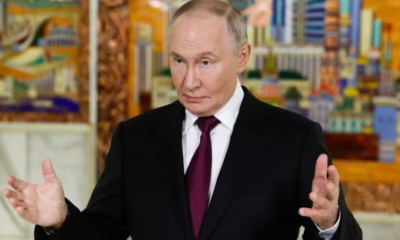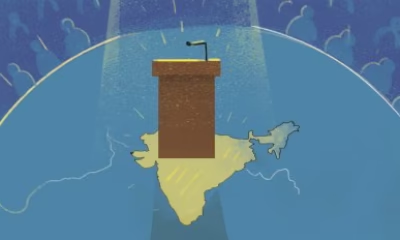
|
Getting your Trinity Audio player ready...
|
(The article was originally published in Indian Express on October 04, 2025 as a part of Dr Madhav’s column titled ‘Ram Rajya’. Views expressed are personal.)
On October 2, #RSS@100 was one of the top ten trending hashtags globally. For the Rashtriya Swayamsevak Sangh (RSS) that turned 100 on that day, there cannot be any better endorsement of its fame and popularity. Not many organizations survive that long. The RSS has not just survived but grew steadily in the last ten decades. In the first quarter of its existence, it faced the wrath, first of the British government, which sought to impose curbs on its activities in Central Provinces in 1930s, and subsequently the Nehruvian clique of the independent Indian leadership that imposed a ban on its activities in 1948.
When the organization turned 50, it faced another ban during the infamous Emergency at the hands of the government led by Indira Gandhi in 1975. Those initial decades saw the RSS facing severe criticism, mischaracterization and demonization by the Nehruvians and Communists who captured important positions in public offices including government, media and academia. Adversaries believed that the organization would buckle and perish, but it did not. On the contrary, it succeeded in winning over the support and sympathy of several of them. Jaya Prakash Narain, who led youths against the RSS in 1948 accusing it of involvement in the murder of Gandhi, turned around in 1970s to tell an RSS gathering that “You are committed and devoted people and also disciplined and imbued with many qualities. It is my expectation from you and, as an elder, it is my prayer, that God may bless you with strength enough to give a new shape to India”. Even Jawaharlal Nehru, who once contended that he shall not allow an inch of India’s territory for the saffron flag to flutter, had to acknowledge RSS’ patriotic role during the Sino-Indian War of 1962. The RSS Swayamsevaks were invited to take part in the Republic Day Parade in January 1963, marching shoulder to shoulder with the soldiers of the Indian armed forces.
At 75, the organization saw one of its pracharaks, Atal Behari Vajpayee, at the helm of the governance of the country, successfully leading a coalition of 23 parties. At 100, another pracharak, Narendra Modi, holds sway not only domestically but globally. Hindutva, sheet-anchor of the RSS school of thought, once regarded by its adversaries as a “fringe ideology”, is today mainstreamed and accepted by millions and millions of Indians. Its cadre, running dozens of organizations in almost all walks of national life, emerged as leaders of the entire society relegating all others into obscurity.
What more is needed for its leadership to celebrate? But, true to its tradition, the RSS has decided not to celebrate the centenary but calibrate its journey of the past carefully and orchestrate a new vision for the next hundred years. Sarsanghachalak Mohan Bhagwat alluded to it in his annual Vijayadashami address at Nagpur recently. His centenary message was not only for the rest of the world, but also importantly for millions of Swayamsevaks and other participants of the vast movement.
In the last hundred years, the RSS grew on the strength of three important aspects. Firstly, it did not become a prisoner of any ideology. Ideology-driven parties and movements, like the Communist Party of India, which incidentally completed 100 years last year, disappeared into oblivion or just remained in buildings and properties. Hindutva, on the other hand, is more a recognition of the core cultural and civilizational identity of this country than any ideology. Dr Hedgewar, the founder of the RSS, drew inspiration for it from leaders like Vivekananda, Aurobindo, Tilak, Gandhi, Savarkar and Ambedkar. For all those leaders, deploying cultural and religious symbols like Ganesh Utsavs, bhajans and fasting were legitimate ways of mobilizing public opinion in support of the independence. Until the advent of Muslim League driven separatism, Indian Muslims too never saw anything alien in those cultural practices.
Hedgewar was categorical at the very inception that the Sangh was “not created to harbour hatred or to destroy anyone”. “Hinduism, the foundation of our culture, is a religion that emphasizes virtuous qualities and teaches us the principle of “Atmavat Sarvabhuteshu” – to treat all beings as ourselves”, he stressed. Bhagwat reiterated that the RSS’ Hindutva is no different from that of those leaders of the freedom movement. It is not an “us versus them” discourse but an effort to unite the entire nation of 1.4 billion people of the country.
Secondly, the RSS grew in last hundred years not because of any outside support but on the strength and dedication of millions of its cadre, whom Balasaheb Deoras, the third Sarsanghachalak, described as “Dev Durlabh Karyakarta” – cadre that even gods envy. It never depended on political or financial power for its growth. It grew stronger in adversity. In states like Kerala, where the adversity is most severe, the RSS registered highest growth. At a time when power and pelf is at its beck and call, there is a need to remember this core principle.
Finally, the RSS drew its strength from the goodwill it generated among millions of countrymen. When the British government sought to impose curbs on it in 1930s, prominent leaders in CP, mostly the Congressmen, stood up against that move. When Nehru sought to implicate the RSS in Gandhi’s murder, Sardar Patel wrote to him that as Home Minister he didn’t find any evidence of its involvement in the same. Eminent citizens stood in support of the RSS to convince Nehru and Patel to lift the ban. Entire Sant Samaj, religious establishment, stands by it today, so are thousands of well-meaning citizens from all sections of the society. This support, which Bhagwat describes as the “Sajjan Shakti” – good citizens of the society – too has been instrumental in its rise.
At 100, the organization must remember these three crucial factors – inclusive thought process, dedicated cadre and goodwill of the citizens – that brought the organization to this victorious pass. It mastered the art of navigating through adversity. Its future course depends on its ability to steer through the present favorability.




